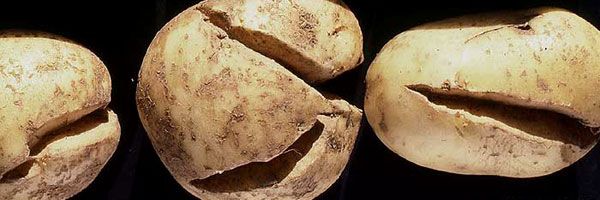
Tuber cracks
- Symptoms
Irregular growth conditions can cause tuber cracks on the tuber’s surface and skin tissues can burst open during tuber enlargment. Depending on the origin, type and intensity of the cracks, symptoms may vary greatly, from the presence of reticulated skin or roughness (photos 1 and 2) to deep single or multiple cracks (photo 3) on the same tuber.
- Risk factors
The main reason for the development of deep cracks is irregular irrigation of the crop during the tuber enlargement stage. Following irregular growth due to drought, watering will bring about rapid rehydration of the vascular tissues. The resulting internal pressure will be greater than the resistance of the skin, which breaks and then heals.
Cultivars with a high proportion of large size tubers are generally more susceptible to this phenomenon, although cultivars such as Bintje are also affected. Excessive nitrogen, a bad soil structure, boron deficiency and low planting densities are the main causes of this disorder.
Similar symptoms may be caused by the presence of common scab (photo 4) and, more often, black scurf (photo 5). Because of the potential toxins present in these pathogens, skin growth is inhibited under and around the mycelium, whilst the rest of the skin grows normally. This leads to highly localised tearing of the skin followed by the formation of cork.
Another, much rarer, cause is the damage caused by capsid bugs (Lygus pabulinus) which pierce young tubers; the bite remains visible at the bottom of the deep crack. The toxins in the saliva of the capsid bugs may retard tuber growth. This may be accompanied by discolouration of the skin.
Finally, certain types of damage may be the result of herbicide phytotoxicity (for example, Rimsulfuron). In this case, several deep cracks on the tuber will usually be observed (photo 6).
- Control
To avoid deep tuber cracks of physiological origin, recommended measures consist of:
- not planting susceptible cultivars;
- good soil preparation in order to ensure good rooting;
- regular and appropriate irrigation to favour even tuber development;
- moderate supply of nitrogen.
In the case of damage due to black scurf, the seed potatoes should be treated with a fungicide before planting.





